英语一般现在时用法详解
- 格式:doc
- 大小:67.50 KB
- 文档页数:9
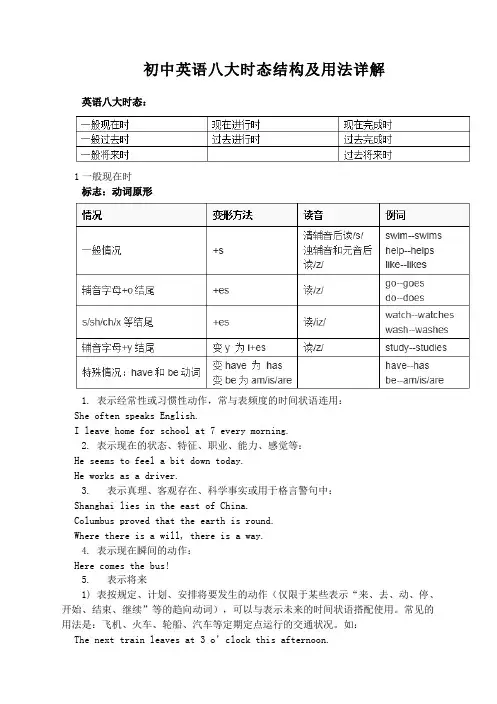
初中英语八大时态结构及用法详解英语八大时态:1一般现在时标志:动词原形1. 表示经常性或习惯性动作,常与表频度的时间状语连用:She often speaks English.I leave home for school at 7 every morning.2. 表示现在的状态、特征、职业、能力、感觉等:He seems to feel a bit down today.He works as a driver.3. 表示真理、客观存在、科学事实或用于格言警句中:Shanghai lies in the east of China.Columbus proved that the earth is round.Where there is a will, there is a way.4. 表示现在瞬间的动作:Here comes the bus!5. 表示将来1) 表按规定、计划、安排将要发生的动作(仅限于某些表示“来、去、动、停、开始、结束、继续”等的趋向动词),可以与表示未来的时间状语搭配使用。
常见的用法是:飞机、火车、轮船、汽车等定期定点运行的交通状况。
如:The next train leaves at 3 o’clock this afternoon.How often does the shuttle bus run?2) 在时间和条件状语从句中常使用一般现在时表示将来发生的事情:When Bill comes (不用will come), ask him to wait for me.I shall go there tomorrow unless I’m too busy.2一般过去时标志:动词过去式*闭音节:元音字母a, e, i, o, u如果发字母本来的音则称为开音节,否则称为闭音节。
1. 表示过去某时所发生的动作或存在的状态,常与表示过去的时间状语连用(e.g. yesterday, this morning, just now, a moment ago, in May, last night / year / week, once upon a time, the other day, before …, when …, in the past等)。
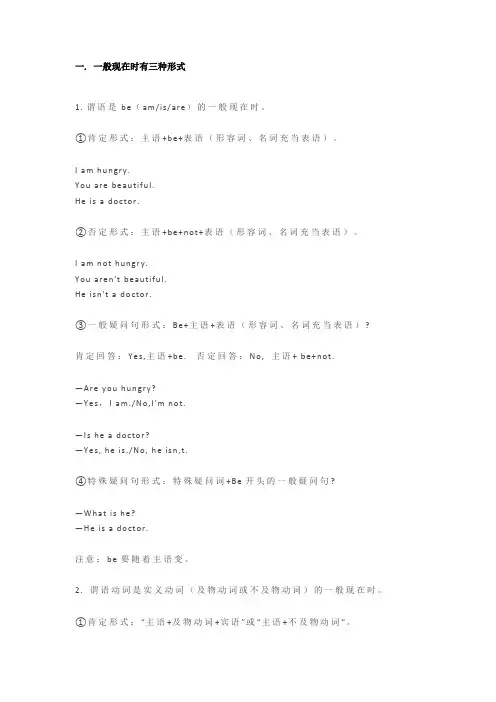
一.一般现在时有三种形式1. 谓语是be(am/is/are)的一般现在时。
①肯定形式:主语+be+表语(形容词、名词充当表语)。
I am hungry.You are beautiful.He is a doctor.②否定形式:主语+be+not+表语(形容词、名词充当表语)。
I am not hungry.You aren't beautiful.He isn't a doctor.③一般疑问句形式:Be+主语+表语(形容词、名词充当表语)?肯定回答:Yes,主语+be. 否定回答:No, 主语+ be+not.—Are you hungry?—Yes,I am./No,I'm not.—Is he a doctor?—Yes, he is./No, he isn,t.④特殊疑问句形式:特殊疑问词+Be开头的一般疑问句?—What is he?—He is a doctor.注意:be要随着主语变。
2. 谓语动词是实义动词(及物动词或不及物动词)的一般现在时。
①肯定形式:“主语+及物动词+宾语”或“主语+不及物动词”。
She has a little brother.她有一个弟弟。
The sun rises in the east.太阳从东方升起。
②否定形式:“主语+don't/doesn't+及物动词+宾语”或“主语+don't/doesn't+不及物动词”。
She doesn't have a little brother.她没有弟弟。
I don't eat every morning.我每天早晨都不吃饭。
③一般疑问句形式:“Do/Does+主语+及物动词原形+宾语”或“Do/Does+主语+不及物动词原形”。
肯定回答:Yes,主语+do/does. 否定回答是:No, 主语+ don't/doesn't.—Do you eat every morning?—Yes, I do./No, I don't.—Does she have a little brother?—Yes, she does./No, she doesn't.④特殊疑问句:特殊疑问词+do/does开头的一般疑问句?What do you like?When do you go to school?注意:根据主语确定用do还是does。
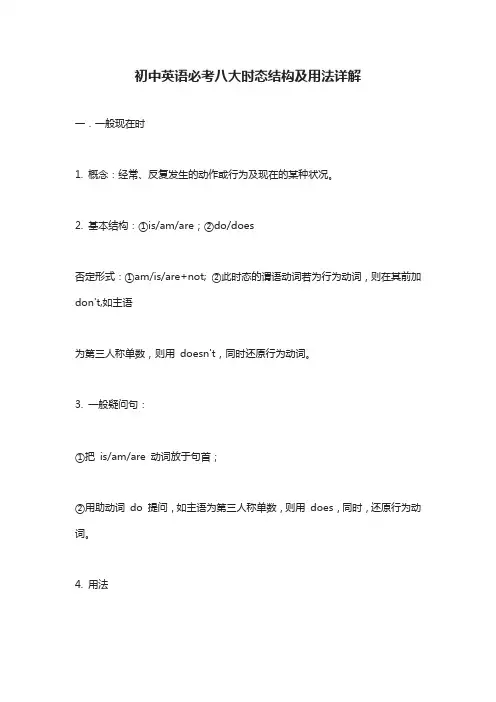
初中英语必考八大时态结构及用法详解一.一般现在时1. 概念:经常、反复发生的动作或行为及现在的某种状况。
2. 基本结构:①is/am/are;②do/does否定形式:①am/is/are+not; ②此时态的谓语动词若为行为动词,则在其前加don't,如主语为第三人称单数,则用doesn't,同时还原行为动词。
3. 一般疑问句:①把is/am/are 动词放于句首;②用助动词do 提问,如主语为第三人称单数,则用does,同时,还原行为动词。
4. 用法1)经常性或习惯性的动作,常与表示频度的时间状语连用。
例如:I leave home for school at 7 every morning. 每天早上我七点离开家。
2)客观真理,客观存在,科学事实。
例如:The earth moves around the sun. 地球绕太阳转动。
Shanghai lies in the east ofChina. 上海位于中国东部。
3)表示格言或警句。
例如:Pride goes before a fall 骄者必败。
注意:此用法如果出现在宾语从句中,即使主句是过去时,从句谓语也要用一般现在时。
例如:Columbus proved that the earth is round. 哥伦布证实了地球是圆的。
4)现在时刻的状态、能力、性格、个性。
例如:I don't want so much. 我不要那么多。
Ann writes good English but does not speak well.安英语写得不错,讲的可不行。
5)一般现在时表示将来含义。
a. 下列动词come, go, arrive, leave, start, begin, return 的一般现在时可以表示将来,主要用来表示在时间上已确定或安排好的事情。
例如:The train leaves at six tomorrow morning. 火车明天上午六点开。

详解一般现在时表将来(9种规律)一、当主句为将来时态或表示将来意义时,时间和条件的状语从句必须用一般现在时表将来:I’ll write to her when I have time. 我有空会给她写信。
Turn off the lights before you l eave. 走前关灯。
If we hurry, we may catch the bus. 如果赶紧走我们可能赶得上公共汽车。
Tell me in case you get into difficulty. 遇到困难请告诉我。
【注】① 除表示时间和条件的状语从句外,表示让步、相似、比例的从句也必须用一般现在时表示将来:I’ll foll ow him wherever he goes. 他去哪儿,我就跟着去哪儿。
Whatever you say, I won’t pay. 无论你说什么,我都不会付钱。
Whether we help him or not, he will fail. 无论我们帮他与否,他都会失败。
I’ll have a good time whether I win or l ose. 赢也好,输也好,我都将会玩好。
The more you eat, the fatter you will become. 你吃得越多就会越胖。
② 另外,当主句为用将来时态时,定语从句也通常用一般现在时表将来:I’ll give you anything you ask for. 你要什么我都给你。
You can have anything I find. 我找到的任何东西你都可以拿去。
Everyone who comes first will get a present. 每个先来的人都可得到一份礼物。
二、按照英语习惯,一个句子中若主要动词已经表明了所谈论动作的时间,那么与之相关的其他动词就不必再次指明同一时间,而往往使用一个比较简单的时态,如用一般现在时表示一般将来时等。
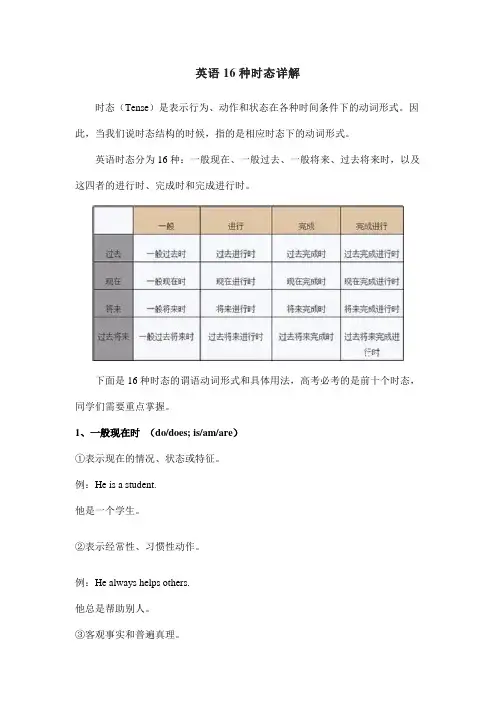
英语16种时态详解时态(Tense)是表示行为、动作和状态在各种时间条件下的动词形式。
因此,当我们说时态结构的时候,指的是相应时态下的动词形式。
英语时态分为16种:一般现在、一般过去、一般将来、过去将来时,以及这四者的进行时、完成时和完成进行时。
下面是16种时态的谓语动词形式和具体用法,高考必考的是前十个时态,同学们需要重点掌握。
1、一般现在时(do/does; is/am/are)①表示现在的情况、状态或特征。
例:He is a student.他是一个学生。
②表示经常性、习惯性动作。
例:He always helps others.他总是帮助别人。
③客观事实和普遍真理。
例:The earth moves the sun.地球绕着太阳转。
④表示一个按规定、计划或安排要发生的动作。
仅限于某些表示“来、去、动、停、开始、结束、继续”等的动词,可以与表示未来时间的状语搭配使用。
常见的用法是:飞机、火车、轮船、汽车等定期定点运行的交通方式。
例:The next train leaves at 3 o'clock this afternoon.下一趟火车今天下午3点开车。
⑤在时间、条件和让步状语从句中经常用一般现在(有时也用现在完成时)表示将的来事情。
(即:主将从现原则)例:I will call you as soon as I arrive at the airport.我一到机场就会给你打电话。
When you have finished the report, I will have waited for about 3 hours.等你完成这份报告的时候,我就已经等了将近3个小时了。
2、现在进行时(am/is/are doing)①表示此时此刻正在发生的事情。
例:He is listning to the music now.他现在正在听音乐。
②表示目前一段时间内一直在做的事情,但不一定此时此刻正在做。
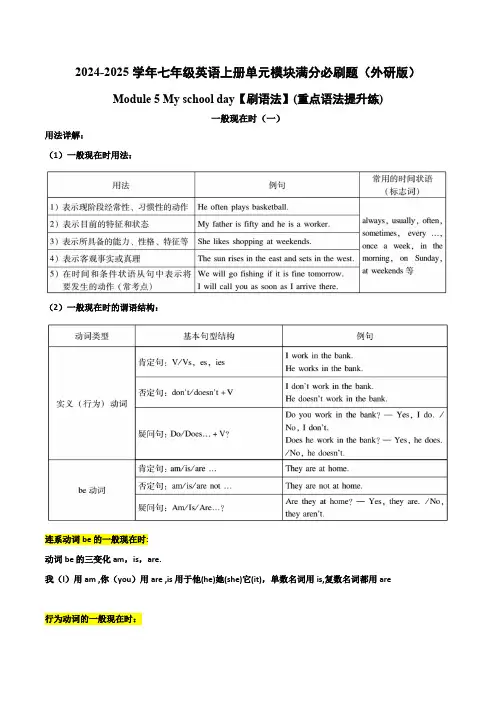
2024-2025学年七年级英语上册单元模块满分必刷题(外研版)Module 5 My school day【刷语法】(重点语法提升练)一般现在时(一)用法详解:(1)一般现在时用法:(2)一般现在时的谓语结构:连系动词be的一般现在时:动词be的三变化am,is,are.我(I)用am ,你(you)用are ,is用于他(he)她(she)它(it),单数名词用is,复数名词都用are行为动词的一般现在时:行为动词的一般现在时的构成:主语+行为动词+(其他)当主语为第三人称单数(he, she, it,某一人或物)时,谓语动词也要用单数形式。
动词的三单形式的变化口诀:动词三单现在时,一般在词尾加Ss, x, ch, sh,在词尾,直接加上-es词尾若是字母o ,加上-es 不用愁。
词尾是“辅音字母+y”,先变y为i,后边再加-es一、单项选择1.More and more people ________ their bikes to work every day.A.rides B.ride C.riding D.will ride 2.Tony and I ________ at school at 7: 30 every morning.A.meets B.meet C.call D.calls 3.—Morning! ________ you Alice?—No. That girl ________ Alice.A.Are, am B.Is, am C.Are, is D.Is, is 4.Kate’s mother________ of medium height and she________ curly hair.A.has; is B.is; has C.is; is D.has; has 5.Now each of the students ________ a computer.A.has B.have C.is having D.are having 6.—________ you play computer games at weekends, Alan?—Yes. But my mother ________ let me play for long.A.Do; doesn’t B.Do; isn’t C.Are; doesn’t D.Are; isn’t 7.The man _______ a white T-shirt ________ a pair of sun glasses.A.wears, wears B.in , wears C.wearing, with D.in , with 8.— How often ________ you ________ books in the evening?— Sometimes.A.is; reading B.are; reading C.does; read D.do; read9.There ________ a park near my home.A.am B.is C.are D.was10.They ________ the room every day.A.clean B.cleans C.is cleaning D.are cleaning11.Betty’s cousins ________ films and they often go to the cinema.A.enjoy B.enjoys C.are enjoying12.My books and magazines ________ in the bookcase.A.is B.are C.am D.be13.We often ________ TV at home.A.watch B.watches C.is watching D.watching14.My classmate ________ a new pencil box, but I ________.A.have, don’t have one B.don’t have, have C.has, do D.has, don’t15.I often ________ my grandparents on weekends.A.visit B.visitsC.visited D.am visiting16.Elephants ________ in groups in Africa and Asia.A.live B.lives C.is living17.We sometimes ________ to the cinema at weekends.A.go B.goes C.is going D.are going18.My classes ________at 3: 00, and after that I do some sports.A.finish B.finishes C.finishing D.to finish19.I ________ my room every day. But now I am ________.A.clean; is reading B.am cleaning; reading C.cleaning; read D.clean; reading 20.—Do we need to buy some more food?—No. There ________ still some in the fridge.A.are B.was C.is D.were二、根据要求改写句子参考答案:1.B【详解】句意:越来越多的人每天骑自行车上班。
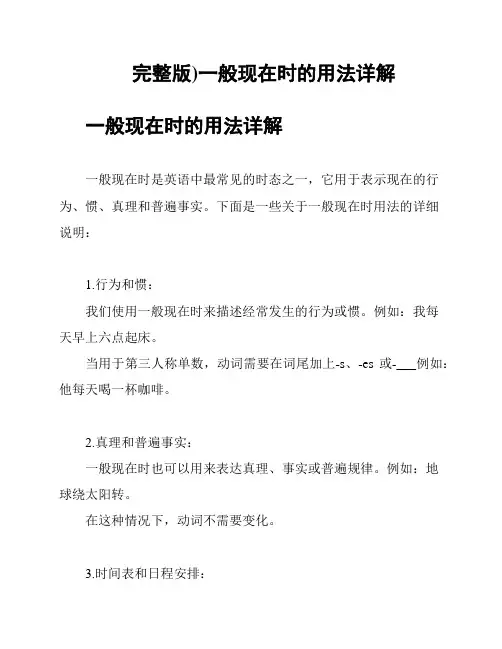
完整版)一般现在时的用法详解一般现在时的用法详解
一般现在时是英语中最常见的时态之一,它用于表示现在的行为、惯、真理和普遍事实。
下面是一些关于一般现在时用法的详细
说明:
1.行为和惯:
我们使用一般现在时来描述经常发生的行为或惯。
例如:我每
天早上六点起床。
当用于第三人称单数,动词需要在词尾加上-s、-es或-___例如:他每天喝一杯咖啡。
2.真理和普遍事实:
一般现在时也可以用来表达真理、事实或普遍规律。
例如:地
球绕太阳转。
在这种情况下,动词不需要变化。
3.时间表和日程安排:
一般现在时也常用于描述时间表、日程安排和固定的安排。
例如:会议在下周三下午三点开始。
在这种情况下,一般现在时表示将来发生的动作。
4.感觉和喜好:
一般现在时也可用于描述感觉、喜好和态度。
例如:我喜欢吃巧克力。
在这种情况下,动词不需要变化。
需要注意的是,一般现在时并不仅限于表示现在发生的事情,还可以包括过去和将来。
它主要用于描述既定的事实和经常性的行为。
因此,在使用一般现在时时,不需要引用不能被确认的内容。
以上是一般现在时用法的简要说明。
希望对您有所帮助!。
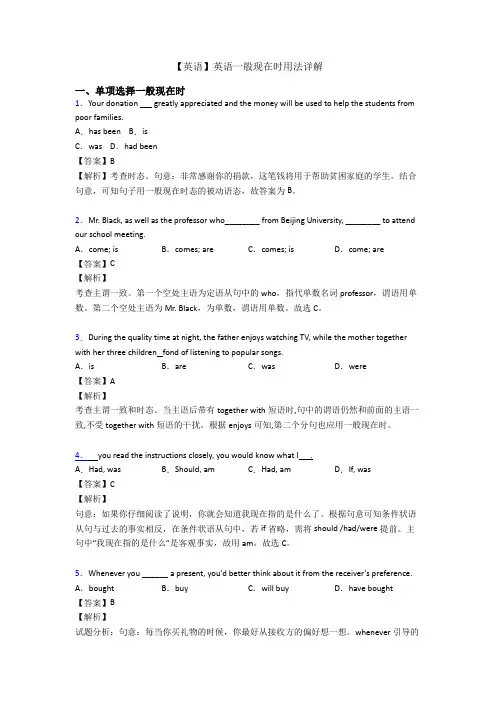
【英语】英语一般现在时用法详解一、单项选择一般现在时1.Your donation greatly appreciated and the money will be used to help the students from poor families.A.has been B.isC.was D.had been【答案】B【解析】考查时态。
句意:非常感谢你的捐款,这笔钱将用于帮助贫困家庭的学生。
结合句意,可知句子用一般现在时态的被动语态,故答案为B。
2.Mr. Black, as well as the professor who________ from Beijing University, ________ to attend our school meeting.A.come; is B.comes; are C.comes; is D.come; are【答案】C【解析】考查主谓一致。
第一个空处主语为定语从句中的who,指代单数名词professor,谓语用单数。
第二个空处主语为Mr. Black,为单数,谓语用单数。
故选C。
3.During the quality time at night, the father enjoys watching TV, while the mother together with her three children fond of listening to popular songs.A.is B.are C.was D.were【答案】A【解析】考查主谓一致和时态。
当主语后带有together with短语时,句中的谓语仍然和前面的主语一致,不受together with短语的干扰。
根据enjoys可知,第二个分句也应用一般现在时。
4. you read the instructions closely, you would know what I .A.Had, was B.Should, am C.Had, am D.If, was【答案】C【解析】句意:如果你仔细阅读了说明,你就会知道我现在指的是什么了。
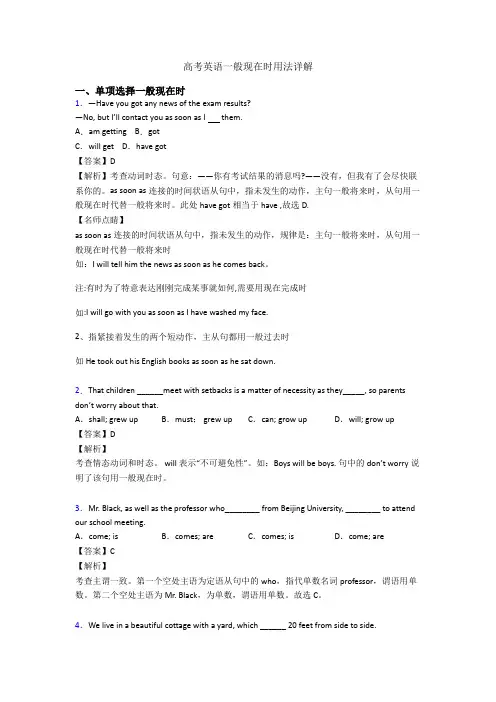
高考英语一般现在时用法详解一、单项选择一般现在时1.—Have you got any news of the exam results?—No, but I’ll contact you as soon as I them.A.am getting B.gotC.will get D.have got【答案】D【解析】考查动词时态。
句意:——你有考试结果的消息吗?——没有,但我有了会尽快联系你的。
as soon as连接的时间状语从句中,指未发生的动作,主句一般将来时,从句用一般现在时代替一般将来时。
此处have got相当于have ,故选D.【名师点睛】as soon as连接的时间状语从句中,指未发生的动作,规律是:主句一般将来时,从句用一般现在时代替一般将来时如:I will tell him the news as soon as he comes back。
注:有时为了特意表达刚刚完成某事就如何,需要用现在完成时如:I will go with you as soon as I have washed my face.2、指紧接着发生的两个短动作,主从句都用一般过去时如 He took out his English books as soon as he sat down.2.That children ______meet with setbacks is a matter of necessity as they_____, so parents don’t worry about that.A.shall; grew up B.must; grew up C.can; grow up D.will; grow up【答案】D【解析】考查情态动词和时态。
will 表示“不可避免性”。
如:Boys will be boys. 句中的don’t worry说明了该句用一般现在时。
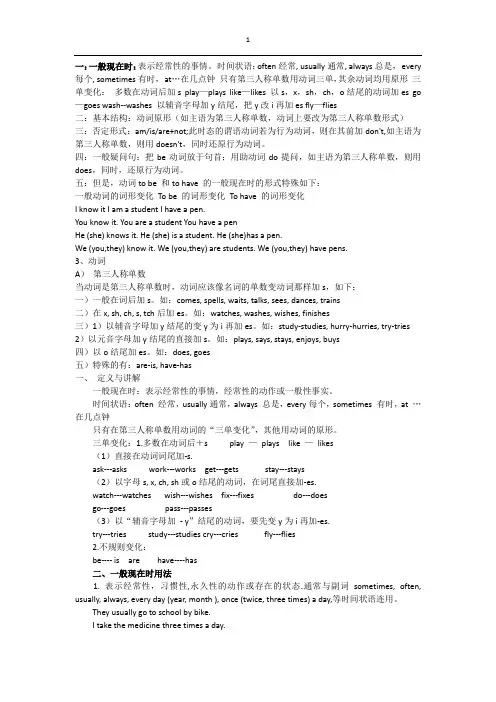
一:一般现在时:表示经常性的事情。
时间状语:often经常, usually通常, always总是,every 每个, sometimes有时,at…在几点钟只有第三人称单数用动词三单,其余动词均用原形三单变化:多数在动词后加s play—plays like—likes 以s,x,sh,ch,o结尾的动词加es go —goes wash--washes 以辅音字母加y结尾,把y改i再加es fly—flies二:基本结构:动词原形(如主语为第三人称单数,动词上要改为第三人称单数形式)三:否定形式:am/is/are+not;此时态的谓语动词若为行为动词,则在其前加don't,如主语为第三人称单数,则用doesn't,同时还原行为动词。
四:一般疑问句:把be动词放于句首;用助动词do提问,如主语为第三人称单数,则用does,同时,还原行为动词。
五:但是,动词to be 和to have 的一般现在时的形式特殊如下:一般动词的词形变化To be 的词形变化To have 的词形变化I know it I am a student I have a pen.You know it. You are a student You have a penHe (she) knows it. He (she) is a student. He (she)has a pen.We (you,they) know it. We (you,they) are students. We (you,they) have pens.3、动词A)第三人称单数当动词是第三人称单数时,动词应该像名词的单数变动词那样加s,如下:一)一般在词后加s。
如:comes, spells, waits, talks, sees, dances, trains二)在x, sh, ch, s, tch后加es。
如:watches, washes, wishes, finishes三)1)以辅音字母加y结尾的变y为i再加es。
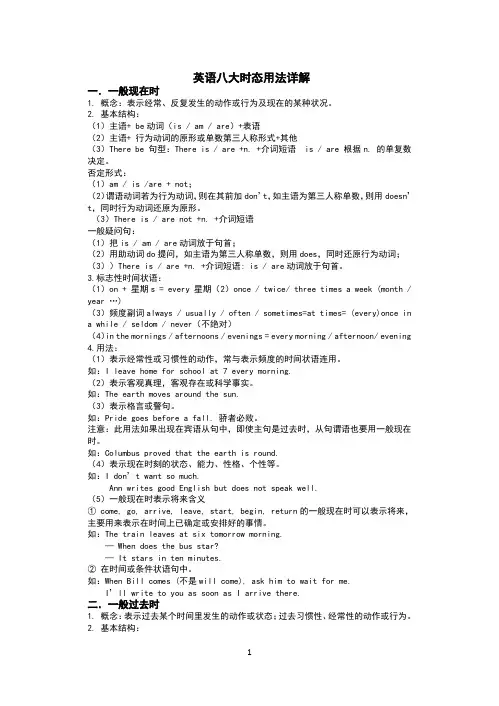
英语八大时态用法详解一.一般现在时1. 概念:表示经常、反复发生的动作或行为及现在的某种状况。
2. 基本结构:(1)主语+ be动词(is / am / are)+表语(2)主语+ 行为动词的原形或单数第三人称形式+其他(3)There be 句型:There is / are +n. +介词短语 is / are 根据n. 的单复数决定。
否定形式:(1)am / is /are + not;(2)谓语动词若为行为动词,则在其前加don’t,如主语为第三人称单数,则用doesn’t,同时行为动词还原为原形。
(3)There is / are not +n. +介词短语一般疑问句:(1)把is / am / are动词放于句首;(2)用助动词do提问,如主语为第三人称单数,则用does,同时还原行为动词;(3))There is / are +n. +介词短语: is / are动词放于句首。
3.标志性时间状语:(1)on + 星期s = every 星期(2)once / twice/ three times a week (month / year …)(3)频度副词always / usually / often / sometimes=at times= (every)once in a while / seldom / never(不绝对)(4)in the mornings / afternoons / evenings = every morning / afternoon/ evening 4.用法:(1)表示经常性或习惯性的动作,常与表示频度的时间状语连用。
如:I leave home for school at 7 every morning.(2)表示客观真理,客观存在或科学事实。
如:The earth moves around the sun.(3)表示格言或警句。
如:Pride goes before a fall. 骄者必败。
英语八大时态用法详解一.一般现在时1. 概念:表示经常、反复发生的动作或行为及现在的某种状况;2. 基本结构:1主语+ be动词is / am / are+表语2主语+ 行为动词的原形或单数第三人称形式+其他3There be 句型:There is / are +n. +介词短语 is / are 根据n. 的单复数决定;否定形式:1am / is /are + not;2谓语动词若为行为动词,则在其前加don’t,如主语为第三人称单数,则用doesn’t,同时行为动词还原为原形;3There is / are not +n. +介词短语一般疑问句:1把is / am / are动词放于句首;2用助动词do提问,如主语为第三人称单数,则用does,同时还原行为动词;3There is / are +n. +介词短语: is / are动词放于句首;3.标志性时间状语:1on + 星期s = every 星期2once / twice/ three times a week month / year …3频度副词always / usually / often / sometimes=at times= everyonce in a while / seldom / never不绝对4in the mornings / afternoons / evenings = every morning / afternoon/ evening4.用法:1表示经常性或习惯性的动作,常与表示频度的时间状语连用;如:I leave home for school at 7 every morning.2表示客观真理,客观存在或科学事实;如:The earth moves around the sun.3表示格言或警句;如:Pride goes before a fall. 骄者必败;注意:此用法如果出现在宾语从句中,即使主句是过去时,从句谓语也要用一般现在时;如:Columbus proved that the earth is round.4表示现在时刻的状态、能力、性格、个性等;如:I don’t want so much.Ann writes good English but does not speak well.5一般现在时表示将来含义① come, go, arrive, leave, start, begin, return的一般现在时可以表示将来,主要用来表示在时间上已确定或安排好的事情;如:The train leaves at six tomorrow morning.— When does the bus star— It stars in ten minutes.②在时间或条件状语句中;如:When Bill comes 不是will come, ask him to wait for me.I’ll write to you as soon as I arrive there.二.一般过去时1. 概念:表示过去某个时间里发生的动作或状态;过去习惯性、经常性的动作或行为;2. 基本结构:1主语+ was / were +表语2主语+ 行为动词的过去式 +其他3There be 句型:There was / were +n. +介词短语4主语+could+动词原形5主语+used to do sth否定形式:1was / were + not;2在行为动词前加didn’t,同时还原行为动词;3There was / were not +n. +介词短语4主语+could not +动词原形5主语+used not to do sth或主语+didn’t use to do sth一般疑问句:1was或were放于句首;2用助动词do的过去式did 提问,同时还原行为动词;3There was / were +n. +介词短语:was或were放于句首;4could放于句首;5Used主语+ to do sth或Did+主语+use to do sth3.时间状语:1last 短语2时间段+ago 3yesterday及yesterday短语4at the age of = when sb. was+年龄5in one’s teens / twenties6固定短语:just now=a moment ago, one day, from then on, at that time, the day before yesterday, before, long before, in the past , in the / early old days, in the ancient days, in the ancient + 国家,long long ago = once upon a time 故事的开头4. 用法:1在确定的过去时间里所发生的动作或存在的状态;如:Where did you go just now2表示在过去一段时间内,经常性或习惯性的动作;如:When I was a child, I often played football in the street.注意:used to do sth“过去常常做某事”,表示过去习惯性的动作或状态,但如今已不存在;如:Mother used not to be so forgetful. 妈妈过去没这么健忘;3用于时间状语从句a. 由when 引导的时间状语从句,从句用一般过去时态,主句用过去进行时态;如:His mother was cooking when he came back.b. 由since/before 引导的时间状语从句,从句用一般过去时态,主句用现在完成时态;如:I have made many friends since I came to China.It has been/is 15 years since I was a teacher.It has been/is 15 years before he knew it. 不知不觉15 年过去了;c. 由when / by the time/ before引导的时间状语从句,从句用一般过去时态,主句用过去完成时态;如:The plane had taken off when / by the time we arrived at the airport.The Enlish class had begun before I got to school.三.现在进行时1. 概念:表示现阶段或说话时正在进行的动作及行为;2. 基本结构:主语 + am / is /are + doing否定形式:主语 + am / is / are + not + doing一般疑问句:把be动词放于句首;3.时间状语:(1)now 2at this time = at this / the moment 3Look/Look at …4Listen / Listen to …5these days / months / years6It is+ 时间点/日期/星期4. 用法:1表示现在指说话人说话时正在发生的事情;如:We are waiting for you.2表示长期的或重复性的动作,说话时动作未必正在进行;如:Mr Green is writing another novel. 说话时并不一定在写小说3表示动作的渐变,这样的动词有:get, grow, become, turn, run, go, begin等;如:The leaves are turning red.It’s getting warmer and warmer.4与always, constantly, forever 等词连用,表示反复发生的动作或持续存在的状态,往往带有说话人的主观色彩;如:You are always changing your mind. 你老是改变主意;5用现在进行时表示将来下列动词come, go, arrive, leave, start, begin, return等瞬间动词的现在进行时可以表示将来;如:I’m leaving tomorrow.四.过去进行时1. 概念:表示过去某段时间或某一时刻正在发生或进行的行为或动作;如:My brother fell while he was riding his bicycle and hurt himself.2. 基本结构:主语 + was / were + doing否定形式:主语 + was / were + not + doing一般疑问句:把was或were放于句首;3. 时间状语:1at that time2at this time+过去的时间3It was+ 时间点/ 日期/ 星期过去4from A时间 to B时间+过去的时间4. 用法:1过去进行时表示过去某段时间内持续进行的动作或者事情;如:We were watching TV from seven to nine last night.2过去进行时可以表示在过去某个时间点发生的事情;时间点可以用介词短语、副词或从句来表示;如:What was she doing at nine o’clock yesterday 介词短语表示时间点She was doing her homework then. 副词表示时间点When I saw him he was decorating his room. when从句表示时间点3在复合句中,如果主要动作和背景动作都是延续的或同时发生的,那么主从句的动词都可用过去进行时;如:When he was waiting for the bus, he was reading a newspaper. 两个动作都是延续的He was cleaning his car while I was cooking. 两个动作同时进行或主句的动作发生在从句的动作过程中五.一般将来时1. 概念:表示将要发生的动作或存在的状态及打算、计划或准备做某事;2. 基本结构:1主语 + am / is / are / going to do sth2主语 + will do sth3主语 + am / is /are t to do sth 4主语 + am / is /are about to do sth否定形式:1主语 + am / is /are + not + going to do sth2主语 + will notwon’t do sth3主语 + am / is /are not t to do sth 4主语 + am / is /are not about to do sth一般疑问句:1am / is / are放于句首;2will置于句首;3am / is / are放于句首;4am / is / are放于句首;2. 时间状语:1tomorrow及其短语、 the day after tomorrow2next短语3固定短语:one day, someday = some day, in the future, from now / today on, before long, sometime, in +时间段多长时间之后, in following+ 时间段4. will主要用于以下三个方面:1表示主观意愿的将来;如:They will go to visit the factory tomorrow.2表示不以人的意志为转移的客观的将来;如:Today is Saturday. Tomorrow will be Sunday.He will be thirty years old this time next year.3表示临时决定,通常用于对话中;— Mary has been ill for a week.— Oh, I didn’t know. I will go and see her.5. be going to主要用于以下两个方面:1表示事先经过考虑、打算、计划要做某事;如:Dad and I are going to watch an opera this afternoon.今天下午我和爸爸打算去看歌剧;2表示根据目前某种迹象判断,某事非常有可能发生,表示推测;如:Look There come the dark clouds. It is going to rain.6. 用于状语从句由when /as soon as / begore / after 等引导的时间状语从句或者if, unless, as/ so long as 引导的条件状语从句,从句用一般现在时态或从句为祈使句,再或者从句中含有情态动词,主句用一般将来时态;可理解为主将从现、主祈从现、主情从现如:Don’t trouble troubles until trouble troubles you.He will help you out whenever you have problems.I won't go to the partyunlessI'm invited.六.过去将来时1. 概念:立足于过去某一时刻,从过去看将来,常用于宾语从句中;2. 基本结构:1主语 + was / were / going to do sth2主语 + would do sth否定形式:1主语 + was / were / not + going to do sth2主语 + would + not + do sth一般疑问句:1was或were放于句首;2would 提到句首;3. 时间状语:the next day morning, year, the following month week等;4. 用法:1“would + 动词原形”常表示主观意愿的将来;如:He said he would come to see me. 他说他要来看我;2“was / were + going to + 动词原形”常表示按计划或安排即将发生的事;如:She said she was going to start off at once.I was told that he was going to return home.此结构还可表示根据某种迹象来看,很可能或即将发生的事情;如:It seemed as if it was going to rain. 看来好像要下雨;3come,go,leave,arrive,start等瞬时动词可用过去进行时表示过去将来的含义;如:He said the train was leaving at six the next morning.She told me she was coming to see me.七.现在完成时1. 概念:过去发生或已经完成的动作对现在造成的影响或结果,或从过去已经开始持续到现在并且有可能继续下去的动作或状态;3. 基本结构:主语 + have / has + done +其他否定形式:主语 + have / has + not +done +其他一般疑问句:Have / Has +主语 + done +其他4. 时间状语:1already 用于肯定句yet否定句和一般疑问句2just, ever, before, never3so far=up to now = until / till now = by now4over/ in the past /last +时间段5by + 时间6by the end of +现在的时间7since +过去时间如具体的年、月、日、钟点等,如:1980, last month, half past six8 since +一段时间+ ago 9recently = lately10in recent +时间段5. 特殊用法:1由since/before 引导的时间状语从句,从句用一般过去时态,主句用现在完成时态;如:I have made many friends since I came to China.It has been/is 15 years since I was a teacher.It has been/is 15 years before he knew it. 不知不觉15 年过去了;(2)用于由that引导的定语从句中,先行词前有形容词的最高级修饰;如:You’re the best teacher that has ever taught me.6. 比较since和forsince 用来说明动作起始时间,for用来说明动作延续时间的长度;如:We haven’t had any guests since we moved in here.I have lived here for more than twenty years.注意:并非有for 作为时间状语的句子都用现在完成时;I worked here for more than twenty years. 我现在已不在这里工作;7. 延续性动词与非延续性动词之间的转换:leave --- be away from borrow --- keep buy --- have begin/start --- be ondie --- be dead finish --- be over open sth --- keep sth openjoin --- be in+组织机构或be a member of+组织机构fall ill / asleep --- be ill / asleep get up---be upcatch / get a cold --- have a cold come here --- be here go there --- be therebecome / get +adj.--- be+adj come back --- be back get to/ arrive/reach --- be inget to know --- know go get out ---be out put on--- wear/ be in /be dressed in八.过去完成时1. 概念:以过去某个时间为参照,在此以前发生的动作或行为,或在过去某动作之前已完成的动作,即“过去的过去”;2. 基本结构:主语 + had done +其他否定形式:主语 + hadn’t done +其他一般疑问句:had置于句首;3. 时间状语:before, by the end of last yearterm, month等;4. 用法:1用于told, said, knew, heard, thought等动词后的宾语从句中;如:She said that she had never been to Paris.2由when / by the time/ before引导的时间状语从句,从句用一般过去时态,主句用过去完成时态;如:The plane had taken off when / by the time we arrived at the airport.The Enlish class had begun before I got to school.When the police arrived, the thieves had run away.3表示意向的动词,如hope, wish, expect, think, intend, mean, suppose等用过去完成时表示“原本······,未能······”;如:We had hoped that you would come, but you didn’t.注意: had hardly… when ... 刚······就······;如:I had hardly opened the door when he hit me. 我刚打开门,他就打了我; had no sooner…than 刚······就······;如:He had no sooner bought the car than he sold it. 他刚买了这辆车,转眼又卖了;。
一般现在时知识点详解(初中英语专题复习)知识点01 一般现在时的构成【语法详解】一般现在时表示经常性的动作或存在的状态,多与时间状语always,often,sometimes,every day,in the morning等连用。
once a week,twice a month等表示频率的词组也常用于一般现在时。
在一般情况下用动词原形,若主语为第三人称单数,一般在动词原形后加-s或-es。
【答案】teaches【详解】句意:王老师在周日教我们英语。
时间状语“on Sundays”是一般现在时标志词,主语“Mr. Wang”是第三人称,动词用三单形式,故填teaches。
知识点02 一般现在时的用法【语法详解】①表示经常性、习惯性的动作或存在的状态。
常与频度副词连用。
I often take a walk in the park. 我经常在公园散步。
These T-shirts are new. 这些T恤衫是新的。
①表示客观事实、真理。
The sun rises in the east and sets in the west. 太阳东升西落。
①在时间、条件状语从句中表示将来的动作。
If it doesn’t rain tomorrow, I will go bike riding in the open air. 如果明天不下雨,我将在户外骑自行车。
I’ll tell her the good news when she comes back. 当她回来的时候,我将把这个好消息告诉她。
①表示按计划或安排将要发生的动作,可用一般现在时表将来。
但只限于start,begin,leave,go,come,arrive,return,take place等。
【即学即练】She’s brought you some eggs. As you know, she ______chickens.A. keepsB. will keepC. has keptD. kept【答案】A【详解】句意:她给你带了些鸡蛋。
初中英语必考八大时态结构及用法详解一、一般现在时1. 概念:经常、反复发生的动作或行为及现在的某种状况。
2. 基本结构:①is/am/are;②do/does否定形式:①am/is/are+not;②此时态的谓语动词若为行为动词,则在其前加don't,如主语为第三人称单数,则用doesn't,同时还原行为动词。
3. 一般疑问句:①把is/am/are动词放于句首;②用助动词do提问,如主语为第三人称单数,则用does,同时,还原行为动词。
4. 用法1) 经常性或习惯性的动作,常与表示频度的时间状语连用。
例如:I leave home for school at 7 every morning. 每天早上我七点离开家。
2) 客观真理,客观存在,科学事实。
例如:The earth moves around the sun. 地球绕太阳转动。
Shanghai lies in the east ofChina. 上海位于中国东部。
3) 表示格言或警句。
例如:Pride goes before a fall. 骄者必败。
注意:此用法如果出现在宾语从句中,即使主句是过去时,从句谓语也要用一般现在时。
例如:Columbus proved that the earth is round. 哥伦布证实了地球是圆的。
4) 现在时刻的状态、能力、性格、个性。
例如:I don't want so much. 我不要那么多。
Ann writes good English but does not speak well.安英语写得不错,讲的可不行。
5) 一般现在时表示将来含义a. 下列动词come, go, arrive, leave, start, begin,return的一般现在时可以表示将来,主要用来表示在时间上已确定或安排好的事情。
例如:The train leaves at six tomorrow morning. 火车明天上午六点开。
高考英语时态和语态详解动词的时态和语态一、时态1、一般现在时(do/does; is/am/are)①表示现在的情况、状态或特征。
例:He is a student.他是一个学生。
②表示经常性、习惯性动作。
例:He always helps others.他总是帮助别人。
③客观事实和普遍真理。
例:The earth moves the sun.地球绕着太阳转。
④表示一个按规定、计划或安排要发生的动作。
仅限于某些表示“来、去、动、停、开始、结束、继续”等的动词,可以与表示未来时间的状语搭配使用。
常见的用法是:飞机、火车、轮船、汽车等定期定点运行的交通方式。
例:The next train leaves at 3 o'clock this afternoon.下一趟火车今天下午3点开车。
⑤在时间、条件和让步状语从句中经常用一般现在(有时也用现在完成时)表示将的来事情。
(即:主将从现原则)例:I will call you as soon as I arrive at the airport.我一到机场就会给你打电话。
When you have finished the report, I will have waited for about 3 hours.等你完成这份报告的时候,我就已经等了将近3个小时了。
2、现在进行时(am/is/are doing)①表示此时此刻正在发生的事情。
例:He is listning to the music now.他现在正在听音乐。
②表示目前一段时间内一直在做的事情,但不一定此时此刻正在做。
例:I am studying computer this term.这个学期我一直在学习计算机。
③现在进行时可以表示将来的含义。
瞬时动词的进行一定表将来。
例:I am leaving.我要离开了。
持续动词的进行只有有将来的时间状语或有将来语境中才表将来。
例:I am travelling next month.下个月我要去旅行。
英语八大时态讲解动词的时态有很多。
初中阶段主要掌握八种:一般现在时、一般过去时、现在进行时、过去进行时、一般将来时、过去将来时、现在完成时、过去完成时。
(一一般现在时1一般现在时态的构成:主语是I, we, you, they和名词复数时作谓语的行为动词用原形。
主语是he, she , it和名词单数时,作谓语的行为动词的词尾变化如下:一般情况+s以s, x, ch, sh 或o结尾+es以辅音+y结尾去y变i+es2一般现在时态的肯定句、否定句和疑问句形式(以be和like为例:He/ She is a student.I / We/ You/ They/ like music.Many people like music. I am not a student.Is he/ she a student?Do you/ they like music?Do many people like music?3一般现在时态的用法:现阶段经常性,习惯性的动作。
例如:I get up at six every morning.He plays tennis once a week.举例:A 现在的状态My mother is a teacher. She teaches English in a school.B 客观真理The earth goes around the sun.4常用于一般现在时态的时间状语:often usually sometimes always every day never in the morning 等。
例题解析:举一反三,学的更轻松!1. --- May I help you, sir?--- Yes, I bought the TV the day before yesterday, but it ______.A. didn’t workB. doesn’t workC. won’t workD. can’t work解析:电视虽然是前天买的,但坏了是现在的状态,应该用一般现在时态。
英语动词时态及用法详解英语动词时态是英语语法中的重要组成部分,它能够帮助我们准确地表达动作发生的时间和状态。
在这篇文章中,我们将详细探讨英语中常见的动词时态及其用法。
一、一般现在时一般现在时表示经常发生的动作、习惯性的行为、客观真理或普遍存在的情况。
其构成是主语+动词原形(当主语是第三人称单数时,动词要加“s”或“es”)。
例如:“I go to school every day”(我每天上学。
)“He likes playing football”(他喜欢踢足球。
)一般现在时常用于以下情况:1、表示日常习惯和规律,如“He gets up early every morning”(他每天早上都早起。
)2、表示客观事实和真理,例如“The earth moves around the sun”(地球绕着太阳转。
)3、表示永恒的状态,“Water boils at 100 degrees Celsius”(水在 100 摄氏度沸腾。
)二、一般过去时一般过去时表示过去某个时间发生的动作或存在的状态。
其构成是主语+动词的过去式。
比如:“I saw a movie yesterday”(我昨天看了一场电影。
)“She was happy last week”(她上周很开心。
)一般过去时的使用场景通常有:1、描述过去发生的一次性动作,“I met her at the party last night”(昨晚在派对上我遇见了她。
)2、讲述过去的习惯或状态,“When I was a child, I often played in the park”(当我还是个孩子的时候,我经常在公园玩。
)三、一般将来时一般将来时表示将来要发生的动作或存在的状态。
常见的构成方式有“will +动词原形”和“be going to +动词原形”。
像:“I will visit my grandparents next weekend”(下个周末我将去看望我的祖父母。